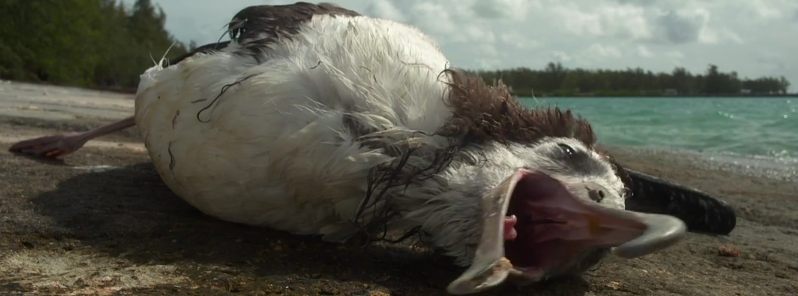Striking research shows 99% of the world’s seabirds will ingest plastic waste by 2050

A team of scientists from Commonwealth Scientific and Industrial Research Organization (CSIRO) and Imperial College London has conducted an in-depth study of the impact the plastic ocean debris has on the ocean's wildlife. The astounding results showed that 99% of seabird population will contain the indigestible plastic pieces in their stomachs by 2050.
It has been long known that plastic debris across the globe's ocean poses a widespread risk to various seabird species, including albatrosses, shearwaters and penguins. Birds are extremely affected by the problem of plastic disposal, as they tend to mistake the brightly colored pieces for food, and swallow them by accident, thus suffering gut impaction, weight loss and sometimes even death.
The research has been lead by Dr. Chris Wilcox and his co-authors Dr. Denise Hardesty and Dr. Erik van Sebille and was published on September 2, 2015, in the Proceedings of the National Academy of Sciences (PNAS).
More depressing research into the scourge of plastic in the oceans: @BBCAmos on a new study of seabirds http://t.co/OviTxmZmZV
— David Shukman (@davidshukmanbbc) August 31, 2015
The results showed that currently, almost 60% of all seabird species have plastic in their stomach, which is a much higher percentage in comparison to only 5% of the seabird population affected by the problem in 1960. By 2010, 80% of seabirds were found to contain plastic debris in their gut, and the modeling outcome predicts that, if the current trend continues, 99% of all the seabirds will have ingested plastics by 2050.
Seabirds are vital to the health of the oceans. 90% of them are filled with plastic. http://t.co/slopBMGioK pic.twitter.com/b60HjZJkvI
— LiliTaylor (@lilitaylor) August 31, 2015
“For the first time, we have a global prediction of how wide-reaching plastic impacts may be on marine species – and the results are striking,” senior research scientist at CSIRO Oceans and Atmosphere Dr Wilcox said.
90% of the seabirds that are still alive have eaten some kind of plastic debris at some point. This includes plastic bags, bottle caps, or fibers from synthetic clothes washed into the ocean by the urban rivers, sewers or waste deposits.
Dr Denise Hardesty from CSIRO Oceans and Atmosphere explained that seabirds were excellent indicators of ecosystem health: “Finding such widespread estimates of plastic in seabirds is borne out by some of the fieldwork we’ve carried out where I’ve found nearly 200 pieces of plastic in a single seabird."
Plastic pollution will have the biggest impact on wildlife in the band around southern edges of Australia, South Africa and South America, the scientist have concluded.
By 2050, nearly all seabirds will have plastic in their stomachs http://t.co/tHDzPRbv1D pic.twitter.com/SKAcDxTXhG
— Newsweek (@Newsweek) September 2, 2015
Dr van Sebille, from the Grantham Institute at Imperial College London, said the plastics had the most devastating impact in the areas where there was the greatest diversity of species: “We are very concerned about species such as penguins and giant albatrosses, which live in these areas. While the infamous garbage patches in the middle of the oceans have strikingly high densities of plastic, very few animals live here.”
Video credit: Chris Jordan, Midway
Dr Hardesty believes there was still the opportunity to change the impact plastic had on seabirds: “Improving waste management can reduce the threat plastic is posing to marine wildlife. Even simple measures can make a difference, such as reducing packaging, banning single-use plastic items or charging an extra fee to use them, and introducing deposits for recyclable items like drink containers."
The results from the efforts to reduce plastic pollution environment in Europe are regarded as encouraging, as the improvements in basic waste management have resulted in measurable changes in plastic in seabird stomachs in less than a decade.


Video credit: World News Channel
Chief Scientist at the US-based Ocean Conservancy Dr George H. Leonard outlined the importance of the study, as it demonstrated how pervasive plastics were in oceans: “Hundreds of thousands of volunteers around the world come face-to-face with this problem during annual Coastal Cleanup events. Scientists, the private sector and global citizens working together against the growing onslaught of plastic pollution can reduce plastic inputs to help protect marine biodiversity.”
Sources: CSIRO, The Abstract of the paper – PNAS
Reference:
- "Threat of plastic pollution to seabirds is global, pervasive and increasing" – Chris Wilcox, Erik Van Sebille, Britta Denise Hardesty – Proceedings of the National Academy of Sciences (2015) – doi: 10.1073/pnas.1502108112
Featured image: Seabird severily affected by the ocean plastic pollution. Midway Island, North Pacific Ocean. Image credit: Chris Jordan

Commenting rules and guidelines
We value the thoughts and opinions of our readers and welcome healthy discussions on our website. In order to maintain a respectful and positive community, we ask that all commenters follow these rules:
We reserve the right to remove any comments that violate these rules. By commenting on our website, you agree to abide by these guidelines. Thank you for helping to create a positive and welcoming environment for all.